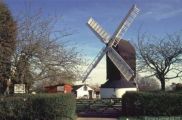
OUTWOOD IN SURREY "The Village with the Mill"
March 2012
The last few days of January and the first two weeks of February produced some really cold weather as an anticyclone from northern Europe settled just off the east coast of England bringing northern and easterly airflows. In Outwood the result was a snowfall of between four and six inches (10-15cms) and very low temperatures made worse by wind chill. Gerald Sharpe of Wasp Green Lane reported that on the evening of Friday 10 February the temperature inside his greenhouse had dropped to minus but this was nothing like the cold weather further east across the North Sea This arctic spell of weather had originated in northern Siberia and the temperatures in Moscow were down to minus 30 . However, what a difference a few days can make: when we found ourselves back in a westerly airstream the snow and ice quickly melted, the afternoon thermometer reading was 10 the snowdrops and hellebores that had been completely covered with snow were ready to open their first early flowers and the spiky bushes of gorse along Brickfield Road just east of Lamberts Place were adorned with rich yellow flowers.
Meanwhile, around the village the cold weather and snow cover had meant that our wild birds could not access their natural foods so gardens and bird feeders were visited by greater numbers of the usual species, plus a number of the less frequently seen and timid birds such as long tailed tits that were attracted to the half coconuts filled with fat and small seeds and any seeds on the Japanese maple left over from their autumn visits. There was also an influx of fieldfares and redwings and both Chris Mann and Tony Cooper in Millers Lane reported seeing them regularly. Both these birds, like the common blackbird, are members of the thrush family. Fieldfares (Turdus pilaris) breed in northern Europe and Asia and winter in the UK where they feed on earthworms and berries; the name derives from the Old English word feldefare meaning traveller through the fields. The redwing (Turdus iliacus) spend the summer months in the breeding grounds in central and southern Europe and winter in the UK where they are often found among flocks of fieldfares; they generally avoid gardens except in cold weather favouring the open countryside where they feed on the berries of rowans and hawthorns. They are smaller and darker than the song thrush and can be easily identified by the creamy white stripe over the eyes and the red colouring of the rump.
One of our visitors over the last three months has been a gorgeous cock pheasant. It has been a regular daily visitor often staying for some hours feeding on the grain and seeds dropped from the bird feeders, preening and looking like an exotic chicken as it pecks around for insects and worms in the fallen leaves. The common or ring necked pheasant (Phaseanus colchicus) is a native of Asia which has been introduced into many countries but generally without success in the southern hemisphere. It was first recorded in Great Britain in the 10th century but arguably came much earlier during the Roman invasion. Their colouring ranges from almost white through to the melanistic or black form. The males weigh on average 1.2kg (2.6lbs) whilst the pale coloured females are around 0.9kg (2lbs). As members of any shooting party will confirm they prefer running to flying but surprisingly for such a large bird, over relatively short distances they can fly at a speed of 90 kph (60mph).
Mike Johnson